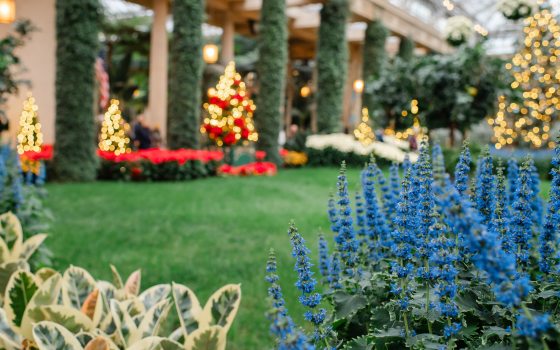This month in the Peirce-du Pont House Conservatory, the beauty of bonsai is on full display—as is the beauty of learning and collaboration. Here in this storied space, you’ll find a rotating selection of 24-first-year chrysanthemum bonsai of 13 cultivars created by a team of 20 Longwood staff and students during a 26-week bonsai and team building workshop—for many of whom serving as their very first bonsai experience. Over those 26 weeks, the team has styled and wired, pinched and repotted, all while flexing their creative muscles, learning from our bonsai experts, and immersing themselves in a living art form that requires patience and adaptation. Now through October 31, we’re proud to showcase the stunning results of their experience, complemented by previously established chrysanthemum bonsai, as well as hardy bonsai in vibrant fall color.
Beyond treating our guests to a resulting selection of spectacular chrysanthemum bonsai, our chrysanthemum bonsai workshop takes place for several reasons. First, it serves as a way to share knowledge and teach skills to staff interested in learning more about bonsai—an essential component of this centuries-old practice that continues on through the work of skilled bonsai artists. With an aim to create a miniaturized but realistic representation of nature in the form of a tree, bonsai demands continual training and assessment of the tree’s shape, structure, and health.
Mastering these horticultural, artistic, and technical skills requires dedication and years of study—not to mention patience and the openness to learn from those before them. The group was led by the expertise of Horticulture Specialty Grower Kevin Bielicki and Bonsai Grower Matt Turner. “The chrysanthemum bonsai workshop is a great example of what makes Longwood such a unique place,” shares Turner. “We are starting with a plant that is ubiquitous in fall settings, but we grow and maintain our own select cultivars. Then we apply well-established techniques to this plant in a unique way to create something beautiful. And we do this in an educational manner, allowing students and staff from throughout horticulture an opportunity to bring a little of their own artistic style or inspiration to the display. They do so while collaborating with each other and expanding their understanding of both the plant material chosen and several of the important concepts of the art of bonsai.”
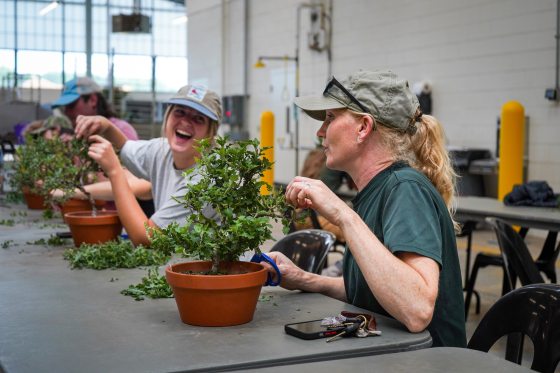
Professional Horticulture Program Student Maggie Lavery (left) and Senior Horticulturist Amy Bloom (right) during one of their workshop sessions. Photo by Carol Gross.
The formal workshop experience began in April—and the mums were ready, having been propagated in January and grown by Longwood production staff in the months leading up. In traditional bonsai, the ideal is to create the appearance of a mature tree in miniature; the workshop participants’ charge was to do so with a chrysanthemum. “We asked the staff and students to think about what makes a tree look old,” shares Bielicki. “We explored the concept of giving the illusion of age through exposed roots, movement in a tree’s trunk, highly developed branching, asymmetry in design, and a thicker trunk with lower branches displaying downward movement.”
Traditional bonsai can be started from a seedling, cutting, nursery stock, or a 30-plus-year-old plant from a garden or the wild. In general, depending what the tree started from, it can take five to 10 years (or much longer) to create a displayable bonsai. When it comes to chrysanthemum bonsai, a tree can be created in nine to 12 months—a quick turnaround that requires a solid game plan. Workshop participants first had to think about how trees grow and use the surrounding landscape as inspiration … and they were encouraged to give each tree a story. As Turner shares, “With this opportunity, staff and students can get hands-on experience with bonsai techniques while actually being able to see the results in the same year.”
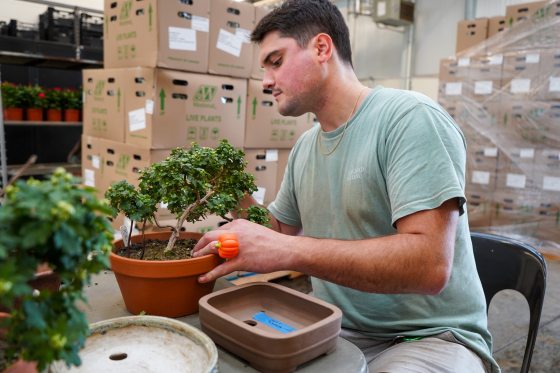
Professional Horticulture Student Tyler Brown inspects one of the two bonsai he created for this year’s display. Photo by Carol Gross.
Their first decision pertained to what form or style they’d want to train their bonsai chrysanthemum into. Without knowing their form or style, they wouldn’t know how best to apply training techniques throughout the process. Style choices were abundant and ranged from semi-cascade (representative of trees found in nature on cliffs or banks, and one in which the tree’s trunk never grows below the base of its container), to informal upright (which depicts a tree in nature that has been affected by the elements, such as wind), to formal upright (in which one follows the tree’s natural design in an upright growing manner, with the trunk line perfectly straight and vertical; the top of the tree located over the center of the trunk base; and the trunk tapering from thicker at the bottom to thinner as it goes up).
Beyond choosing their desired style, participants also had to choose their desired chrysanthemum cultivar, taking into account the cultivar’s growth data, including flower color and size, leaf size, bloom timing, and more. And if that wasn’t enough to consider, they had to actually transform the cutting into a bonsai, following set steps throughout those 26 weeks.
To Senior Horticulturist Amy Bloom, who created an informal upright-style bonsai of the Kotoi-no-karori cultivar, the process was very new, but very exciting. “There’s an art to it, and it’s very exciting to have an idea of what you want to achieve and then adapt along the way,” shares Bloom. “Working in the outdoor landscape as I typically do, I can’t manipulate the trees and plants to this extent and shape, and it was such an eye-opening experience being able to do so.”
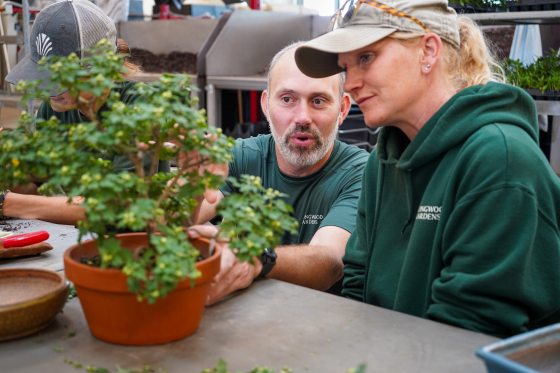
Bonsai Grower Matt Turner (left) and Senior Horticulturist Amy Bloom (right) check on Bloom’s bonsai progress during a September workshop session. Photo by Carol Gross.
To kick things off, participants repotted their selected cuttings into clay pots in late April. In early May, when the potential of frost had moved on, they moved them outside to full sun and then jumped into beginning to style, wire, prune, and pinch. Major initial steps included leaf removal (namely removing large leaves to encourage auxiliary buds to grow; leaves that were growing inward; and leaves that were dead, yellow, or compromised) and wiring, during which wire is used to position the trunk or branches into the desired form. Participants had to choose the wire size based on the thickness and rigidity of the branches to make sure the wire was heavy enough to move the branch, as well as wire at a particular angle, and check the wiring every one to two weeks to prevent scarring.
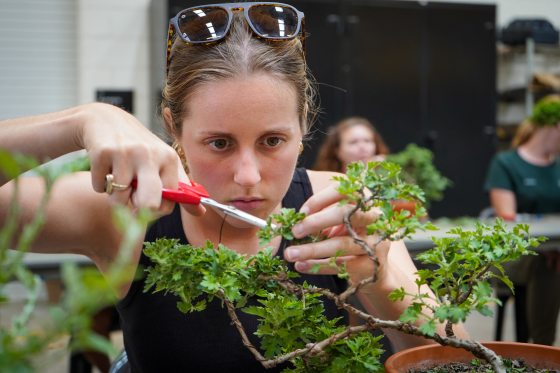
Professional Horticulture Student Mary Featherstone works on pruning and developing more refined branching. Photo by Carol Gross.
From there, the trees required many progress checks, during which participants would rewire, prune, repot following the trees’ growth, and pinch flower buds for balance of growth. Starting in late September, participants engaged in a final big step—potting their trees into display containers, as selected by Bielicki and Turner. As in all bonsai, the container contributes to the character of the bonsai’s composition, complementing the tree.

Repotting can be a strenuous, stressful exercise. Here, Conservatory Horticulturist Rick Fountas (left) consults with Horticultural Specialty Grower Kevin Bielicki (right) in preparation for placing his bonsai in the display pot. Photo by Carol Gross.
Professional Horticulture Program Student Tyler Brown ended up creating a semi-cascade style bonsai, as well as an informal upright style bonsai, both using the cultivar Kiku #5. Brown came to the workshop with bonsai experience but challenged himself by creating two trees of differing styles and using a fast-growing cultivar. “I loved the creative freedom I found working with the bonsai,” he shares. “They grow so fast and you have to keep up with them, yet be meticulous and thoughtful with the way you style along the way.”
As with most in life, participants faced hurdles and tough decisions throughout the process. One of Conservatory Horticulturist Rick Fountas’ two bonsai—a bonsai of root-over-rock style that Fountas has been developing for three years now—was partially blown off its rock during a storm, altering its intended angle. In response, Bielicki helped Fountas solidify the attachment to the rock, and then repositioned its branches to both align with the new angle of the trunk and to ensure better balance of sunlight to the canopy. “We adapted to what happened,” Fountas shares. “And ultimately it was just part of the tree’s story.”

Fountas addresses storm damage to the bonsai, solidifying its attachment to the rock. Photo by Carol Gross.
“Sharing the talent of our Longwood team after nine months of work makes it all worthwhile,” shares Bielicki. “To see the chrysanthemum bonsai next to one another on display, get a glimpse of their flowers opening, and show the diversity of colors and styles all in one place is wonderful, as is highlighting the individuality of each of the makers. It is a team effort to make projects like this come to life. It truly expresses the beauty Longwood has to offer and hopefully serves a source of inspiration for those who visit and who may want to take on their own bonsai endeavor.”
Our rotating selection of chrysanthemum bonsai is on view in our Peirce-du Pont House Conservatory now through October 31.

Conservatory Intern Ava Anderson begins to place chrysanthemum bonsai for display in the Peirce-du Pont House Conservatory—her bonsai is on display as well. Photo by Carol Gross.

Fountas’ root-over-rock bonsai—which was partially blown off its rock during the workshop process—on display in the Peirce-du Pont House Conservatory. Photo by Carol Gross.

Fountas’ second chrysanthemum bonsai (back center). This Kiku #5 upright was started by Longwood Intern Celia Watson this summer; after Watson returned to school, Fountas helped see the bonsai to completion. Photo by Carol Gross.
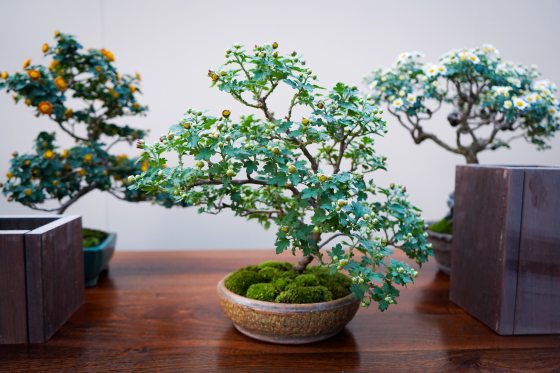
Bloom’s chrysanthemum bonsai, awaiting final display placement. Photo by Carol Gross.
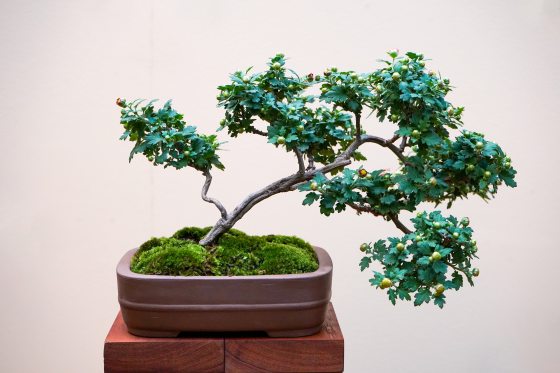
One of Brown’s two chrysanthemum bonsai, this one in semi-cascade style. Photo by Carol Gross.
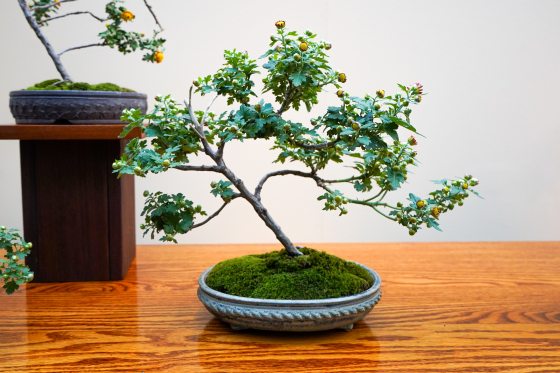
Brown’s second chrysanthemum bonsai, in the informal upright style. Photo by Carol Gross.
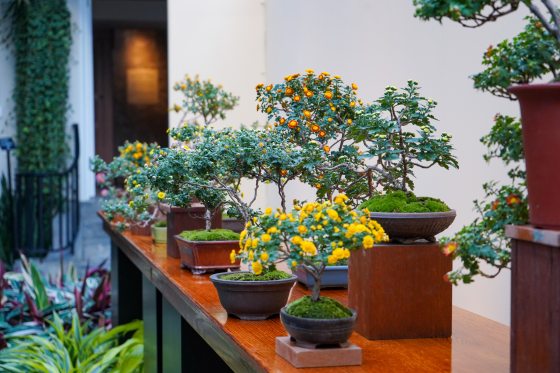
Our rotating selection of chrysanthemum bonsai awaits you. Photo by Carol Gross.

